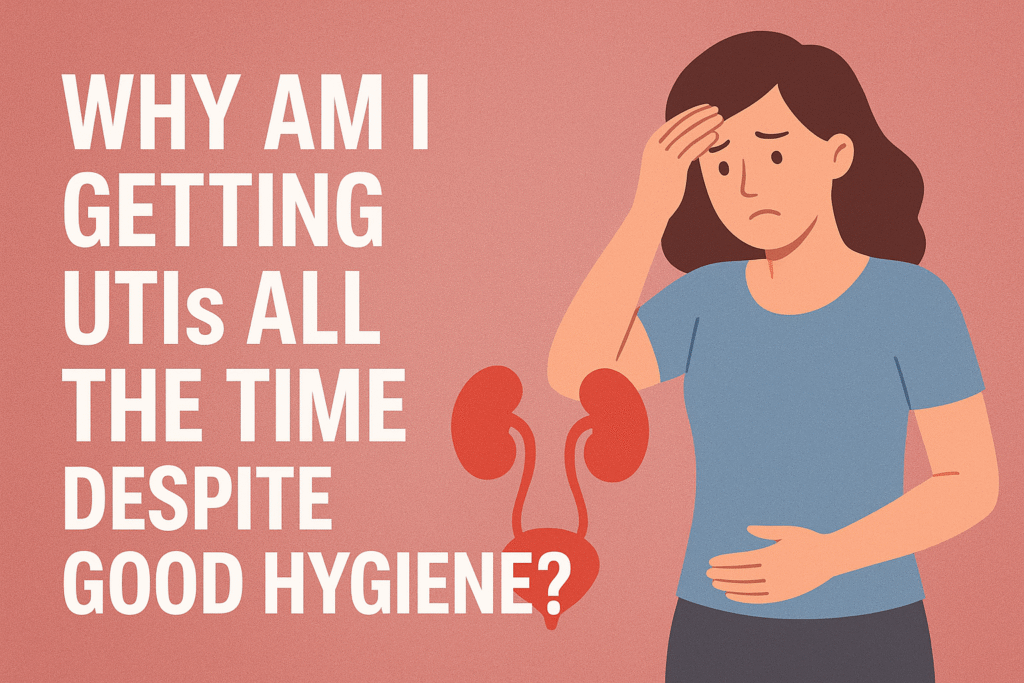
⚠️ Affiliate Disclaimer: This post may contain affiliate links, which means I may earn a small commission — at no extra cost to you — if you make a purchase through one of these links. I only recommend products or services I genuinely trust and believe can provide value. Thank you for supporting My Medical Muse!
Why am I getting UTIs all the time despite good hygiene
Why Am I Getting UTIs All the Time Despite Good Hygiene?
Urinary Tract Infections (UTIs) are one of the most common bacterial infections worldwide, especially among women. For some, they’re an occasional inconvenience, but for others, they become a recurring frustration. If you find yourself battling UTIs again and again even though you practice careful hygiene, you’re not alone. Many people ask the same question, “Why does this keep happening to me?”
The reality is that UTIs are rarely just about hygiene while habits like wiping front to back, staying clean, and wearing breathable clothing help reduce risk, they don’t tell the full story. Research shows that recurrent UTIs are more often linked to anatomical factors, hormonal changes, microbiome imbalances, lifestyle habits, or underlying health conditions than to hygiene alone.
In this guide, we’ll explore:
- Why UTIs can recur despite good hygiene
- Hidden causes and overlooked risk factors
- Evidence-based prevention strategies
- When it’s time to see a doctor for further testing
If UTIs keep disrupting your daily life, understanding the real root causes is the first step toward long-term relief. Let’s break it down.
What Exactly Is a UTI?
A Urinary Tract Infection (UTI) develops when harmful bacteria, most often Escherichia coli (E. coli), enter the urinary system and begin to multiply, while E. coli naturally lives in the gut without causing problems, it can trigger infection when it spreads into the urinary tract.
The urinary tract is made up of several organs that work together to produce and eliminate urine:
- Urethra: the tube that carries urine from the bladder out of the body
- Bladder: the storage organ that holds urine until you urinate
- Ureters: narrow tubes that transport urine from the kidneys to the bladder
- Kidneys: bean-shaped organs that filter waste from the blood and produce urine
Most infections affect the lower urinary tract (the bladder and urethra). This is why UTIs are often referred to as cystitis (bladder infection) or urethritis (urethral infection). However, if bacteria travel upward and reach the kidneys, the infection becomes more serious and is known as pyelonephritis. Kidney infections can cause fever, flank pain, and complications if left untreated.
Common Symptoms of a UTI
Typical signs and symptoms include:
- Burning or stinging during urination
- Frequent urge to urinate, even when little or no urine comes out
- Cloudy or strong-smelling urine
- Pelvic pressure or lower abdominal pain
- Blood in the urine (hematuria) in some cases
- Fever, chills, or back pain if the infection spreads to the kidneys
Because UTI symptoms can overlap with other conditions (like interstitial cystitis or vaginal infections), it’s important to get a proper medical diagnosis, especially if you experience them often.
Risk Factors by Age and Life Stage
UTIs can strike at any age, but the triggers often differ depending on life stage:
- Children: More common in girls due to short urethra, constipation and holding in urine are frequent triggers.
- Young women: Sexual activity and certain contraceptives (like spermicides or diaphragms) are the leading causes.
- Pregnancy: Hormonal changes relax the urinary tract, slowing urine flow. The growing uterus also puts pressure on the bladder, increasing infection risk.
- Perimenopause & Menopause: Falling estrogen levels thin the vaginal lining, alter pH, and reduce protective Lactobacillus, making infections more likely.
- Older adults: Increased risk due to bladder emptying problems, chronic conditions (like diabetes), or catheter use.
Understanding these age related risks helps tailor prevention strategies to your life stage.
Why Hygiene Isn’t Always the Problem
It’s a common belief that urinary tract infections are simply the result of “poor hygiene.” while personal hygiene practices like wiping front to back, showering regularly, and wearing breathable underwear can reduce risk, they do not eliminate the deeper causes of recurrent infections.
Research shows that most repeat UTIs are linked to factors beyond hygiene, including anatomy, sexual activity, hormonal changes, microbiome imbalances, and even underlying medical conditions. If you’re struggling with frequent infections despite “doing everything right,” it’s time to look at the broader picture.
Here are the key reasons why UTIs may keep coming back:
1. Anatomy and Biology Play a Big Role
Some people are more vulnerable to UTIs simply because of their anatomy.
- Shorter urethra in women: A woman’s urethra is only about 1.5 inches long compared to a man’s 8 inches. This gives bacteria a much shorter pathway to the bladder.
- Proximity to the anus: The urethra sits very close to the vagina and anus, making it easier for gut bacteria such as E. coli to spread.
- Bladder emptying issues: If urine isn’t fully expelled, whether due to muscle weakness, nerve dysfunction, or incomplete urination, residual bacteria can linger and multiply.
Even with flawless hygiene, these biological realities make women far more prone to infections than men.
2. Sexual Activity and UTIs
You may have heard the term “honeymoon cystitis,” which refers to UTIs triggered by sexual activity. Intercourse can push bacteria from the genital and anal area directly into the urethra.
Risk factors include:
- Frequent or vigorous sexual activity
- Use of spermicides or diaphragms (these disrupt vaginal flora)
- Having a new sexual partner
- Not urinating after sex (which normally helps flush out bacteria)
If your infections often follow intimacy, this could be the main trigger.
3. Hormonal Shifts
Hormones, especially estrogen provide important protection for the urinary tract. When levels shift, vulnerability increases.
- Menopause: Falling estrogen levels thin the vaginal and urethral tissues, reduce natural lubrication, and alter vaginal pH, creating an environment where harmful bacteria thrive.
- Perimenopause and postpartum: Fluctuating hormones during these stages can also weaken defenses.
- Contraceptives Certain birth control methods, like pills or IUDs, may slightly alter the vaginal microbiome, increasing susceptibility.
This is why many women who never had UTIs in their younger years suddenly start experiencing them in midlife or after childbirth.
4. Vaginal and Gut Microbiome Imbalance
The vagina and urinary tract rely heavily on “good bacteria,” especially Lactobacillus, to maintain balance and fend off harmful microbes. When this protective barrier is disrupted, infections are much more likely.
What disrupts the microbiome?
- Repeated antibiotic use (wiping out both good and bad bacteria)
- Vaginal douching or harsh soaps
- Uncontrolled diabetes (high blood sugar feeds bacterial growth)
- Digestive problems or poor gut health (reducing beneficial bacteria)
Maintaining a healthy microbiome is just as important as maintaining hygiene.
5. Hidden Medical Conditions
Recurrent UTIs may sometimes point to an underlying health issue:
- Kidney or bladder stones: Can trap bacteria, making infections harder to clear
- Diabetes: High glucose levels in urine fuel bacterial growth and weaken immunity
- Immune system disorders: Reduce the body’s natural infection defenses
- Pelvic organ prolapse: Causes incomplete bladder emptying
- Interstitial cystitis or overactive bladder: Conditions that mimic UTIs but require different treatment
If your UTIs don’t respond to standard antibiotics or keep returning quickly, it’s worth asking your doctor to check for these conditions.
6. Lifestyle Habits That May Be Working Against You
Even if your hygiene is excellent, daily habits can unintentionally raise your risk:
- Not drinking enough water: Less urine means bacteria aren’t flushed out frequently.
- Holding in urine: Delaying urination allows bacteria time to multiply.
- Tight clothing: Traps warmth and moisture, creating an ideal bacterial environment.
- High-sugar diet: Feeds both vaginal yeast and urinary bacteria.
- Scented products: Bubble baths, perfumed pads, and feminine washes disrupt natural defenses.
Sometimes, small lifestyle adjustments can make a big difference in prevention.
7. Antibiotic Resistance
One of the most overlooked contributors to repeat UTIs is antibiotic resistance.
- After multiple courses of antibiotics, bacteria may adapt and stop responding to treatment.
- Antibiotics also destroy protective bacteria in the vaginal and gut microbiome, leaving you more vulnerable to reinfection.
If it feels like antibiotics “don’t work anymore,” ask your doctor about a urine culture test. This test identifies the exact bacteria causing infection and determines which medications will still be effective.
8. Genetic Susceptibility
Sometimes, the tendency to develop recurrent UTIs runs in families. Research has shown that genetic variations in immune system function and bladder cell receptors can make it easier for bacteria, especially E. coli to attach and multiply.
If your mother, sisters, or close female relatives also struggle with frequent UTIs, genetics may be partly responsible. While you can’t change your genes, knowing this can help you and your doctor take a more proactive prevention approach.
UTI or Something Else? Key Differences to Know
UTI symptoms often overlap with other conditions, which can make self-diagnosis tricky. Burning, urgency, or pelvic discomfort doesn’t always mean infection. Here’s how UTIs compare to other common issues:
Condition | Key Symptoms | Cause | Treatment |
Urinary Tract Infection (UTI) | Burning with urination, frequent urge, cloudy/foul-smelling urine, sometimes blood | Bacterial infection (commonly E. coli) | Antibiotics, hydration, prevention strategies |
Yeast Infection | Intense itching, thick white discharge, redness/swelling | Overgrowth of Candida yeast | Antifungal medication (oral or topical) |
Bacterial Vaginosis (BV) | Thin gray discharge, strong “fishy” odor, mild irritation | Imbalance in vaginal bacteria | Antibiotics (metronidazole or clindamycin) |
Interstitial Cystitis (IC) | Bladder/pelvic pain, frequent urination, no bacteria found | Chronic bladder condition (non-infectious) | Bladder training, lifestyle, specialized treatments |
If you have recurrent “UTIs” that test negative, or if antibiotics don’t help, ask your doctor to check for these alternatives.
How UTIs Are Diagnosed
Because UTI symptoms can mimic other conditions, proper testing is essential before starting treatment. Doctors typically use:
- Urinalysis: A quick dipstick test to detect white blood cells, red blood cells, and nitrites (markers of infection).
- Urine culture: Grows bacteria from your urine to identify the exact type and determine which antibiotics work best. This is crucial for recurrent UTIs or antibiotic resistance.
- Imaging tests (ultrasound, CT scan): Ordered if infections are severe, frequent, or if structural problems (like kidney stones) are suspected.
- Cystoscopy: A small camera used to inspect the bladder in chronic or unexplained cases.
Don’t rely solely on symptoms, getting the right test ensures the right treatment and helps prevent recurrence.
How to Prevent Recurrent UTIs Beyond Hygiene
If hygiene alone isn’t enough, the next step is to adopt evidence-based strategies that reduce bacterial growth, support urinary tract health, and prevent reinfection. Here’s what actually helps:
1. Hydration and Bladder Health
- Aim for 2-3 liters of water daily to keep urine diluted and bacteria flushed out.
- Urinate every 2-3 hours rather than holding it in, which gives bacteria more time to multiply.
- Take your time to fully empty your bladder, lean forward slightly if needed, especially if you feel incomplete emptying.
2. Post-Sex Prevention
Because sexual activity is a major trigger for many women:
- Urinate immediately after intercourse to flush out bacteria.
- Rinse gently with plain water if needed, but avoid harsh soaps or douching.
- For women with frequent post-intercourse UTIs, doctors may prescribe single-dose preventive antibiotics to take after sex.
3. Support Your Microbiome
Your body’s natural bacterial balance is a powerful defense system. Protect it by:
- Taking probiotics with Lactobacillus strains (oral or vaginal), which help restore healthy flora.
- Avoiding unnecessary or repeated antibiotic use.
- Eating a fiber-rich diet that supports gut health, since gut bacteria influence urinary and vaginal microbiomes.
4. Hormone Support (for Midlife and Beyond)
For women in perimenopause or menopause, falling estrogen levels can increase UTI risk. Options include:
- Vaginal estrogen creams or rings, which restore protective vaginal tissues and reduce recurrences.
- Discussing hormone-based or non-hormonal alternatives with your gynecologist if UTIs began after menopause or childbirth.
5. Natural and Supplement Options
Some natural approaches have evidence for reducing UTIs:
- D-mannose: A natural sugar that binds E. coli, preventing it from sticking to bladder walls.
- Cranberry extract: Contains compounds (PACs) that may reduce bacterial adhesion. (Note: cranberry juice is less effective due to sugar content and lower concentration.)
- Vitamin C: May acidify urine slightly and support immune function.
- Magnesium and sleep hygiene: Help calm bladder nerve overactivity, which can worsen urgency and frequency.
Always consult your doctor before starting supplements, especially if you’re pregnant, breastfeeding, or taking other medications.
6. Medical Solutions for Frequent UTIs
If lifestyle changes aren’t enough, medical interventions may help:
- Urine culture testing Identifies the exact bacteria and determines which antibiotics work best.
- Low-dose prophylactic antibiotics: For women with three or more UTIs per year, short-term daily or post-intercourse antibiotics can prevent recurrence.
- Bladder instillations or vaccines: Emerging treatments currently under research may offer longer-term solutions.
- Treating underlying conditions: Managing diabetes, removing bladder stones, or correcting pelvic prolapse can drastically reduce UTI risk.
When to See a Doctor
While some UTIs are straightforward and respond quickly to treatment, recurrent or severe cases require medical evaluation. Ignoring symptoms can allow an infection to progress to the kidneys or mask an underlying health problem.
Seek medical attention if:
- You experience three or more UTIs per year despite preventive measures.
- Symptoms persist after completing antibiotics.
- You notice blood in your urine (hematuria).
- You develop fever, chills, nausea, or back/flank pain, which may signal a kidney infection.
- You are pregnant, since UTIs during pregnancy can increase risks for both mother and baby.
- You have a weakened immune system or chronic conditions like diabetes that complicate infections.
Don’t hesitate to ask for a urine culture test, it’s often the key to uncovering antibiotic resistance or unusual bacteria that standard treatments miss.
FAQs on Recurrent UTIs
1. Can men get recurrent UTIs too?
Yes, although it’s much less common than in women. When men develop recurrent UTIs, it often points to an underlying issue such as enlarged prostate, kidney stones, or urinary tract obstruction. Men with persistent infections should always be evaluated by a doctor.
2. Can a UTI go away on its own?
Occasionally, mild infections may resolve without treatment, but this is risky. Untreated UTIs can spread to the kidneys, causing serious complications. Medical treatment is strongly advised, especially for people with repeated or severe symptoms.
3. Why do antibiotics stop working?
Bacteria can develop antibiotic resistance after repeated exposure, making standard drugs less effective. In these cases, a urine culture and sensitivity test is essential to identify which antibiotic will still work.
4. Can stress cause UTIs?
Stress does not directly cause infections, but it can weaken the immune system and make the body less effective at fighting off bacteria. Stress may also contribute indirectly by disrupting sleep and hormone balance, which can affect urinary health.
5. Are recurrent UTIs the same as interstitial cystitis?
Not necessarily. Interstitial cystitis (IC), sometimes called “painful bladder syndrome,” mimics UTI symptoms like urgency, frequency, and pelvic pain but isn’t caused by bacteria. If your urine tests keep coming back negative despite symptoms, interstutial cystitis may be worth exploring with a urologist.
Final Thoughts
If you’re struggling with recurrent UTIs despite careful hygiene, remember this, it isn’t your fault. Hygiene is only one piece of a much larger puzzle. Factors such as anatomy, hormones, sexual activity, microbiome health, lifestyle habits, medical conditions, and even genetics all play a role in making some people more prone to infections than others.
The encouraging news is that there are many proven strategies to reduce UTI recurrence from staying hydrated and supporting your microbiome, to using post-sex prevention, hormonal support, or targeted medical treatments when needed. With the right approach, most people can dramatically cut down on infections and regain control over their urinary health.
Instead of blaming yourself or relying solely on hygiene habits, view persistent UTIs as a signal from your body. By working with a healthcare professional, you can uncover the root causes and find a tailored prevention plan that finally brings long-term relief.
UTIs may be common, but they don’t have to control your life. With awareness, proactive steps, and the right medical guidance, lasting freedom from recurrent infections is absolutely possible.
👩⚕️ Need Personalized Health Advice?
Get expert guidance tailored to your unique health concerns through MuseCare Consult. Our licensed doctors are here to help you understand your symptoms, medications, and lab results—confidentially and affordably.
👉 Book a MuseCare Consult NowRelated Post You Might Like:
- Stopped Breastfeeding and Can’t Sleep? 7 Proven Ways to Beat Hormonal Rebound Insomnia
- Preventive Screenings for Women’s Health: 10 Essential Tests to Stay Healthy at Every Age
- 12 Early Warning Signs of Thyroid Issues in Women Over 35 You Need to Know
- 13 Sneaky Signs of Magnesium Deficiency in Women (And How to Fix It Naturally)
- 10 Sneaky Symptoms of Prediabetes in Women Over 40 You Can’t Ignore


